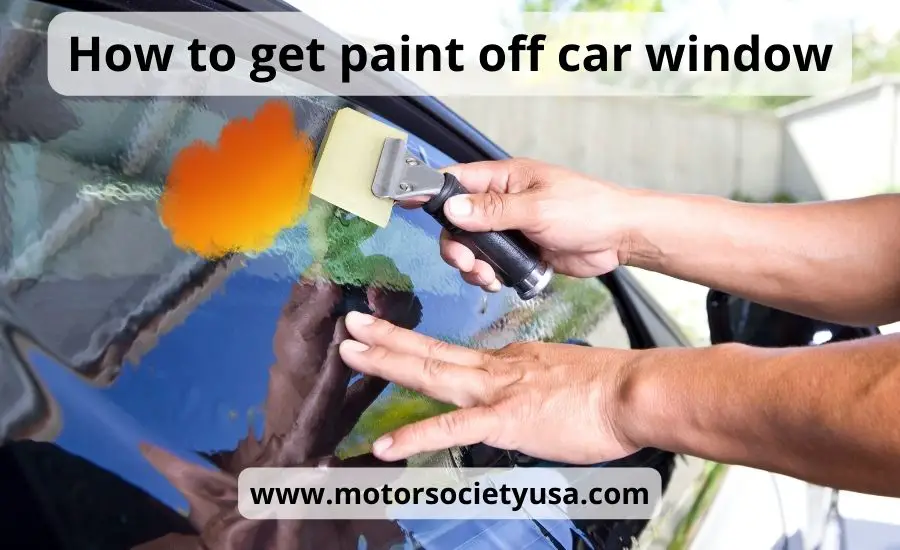Having paint on the glass of your vehicle can be very frustrating especially if it wasn’t intentionally painted, this can be due to several reasons and this unwanted paint stain can be very disturbing.
Different approaches to this spray paint issue will be examined in this article explaining how you can effectively make your window paint free.
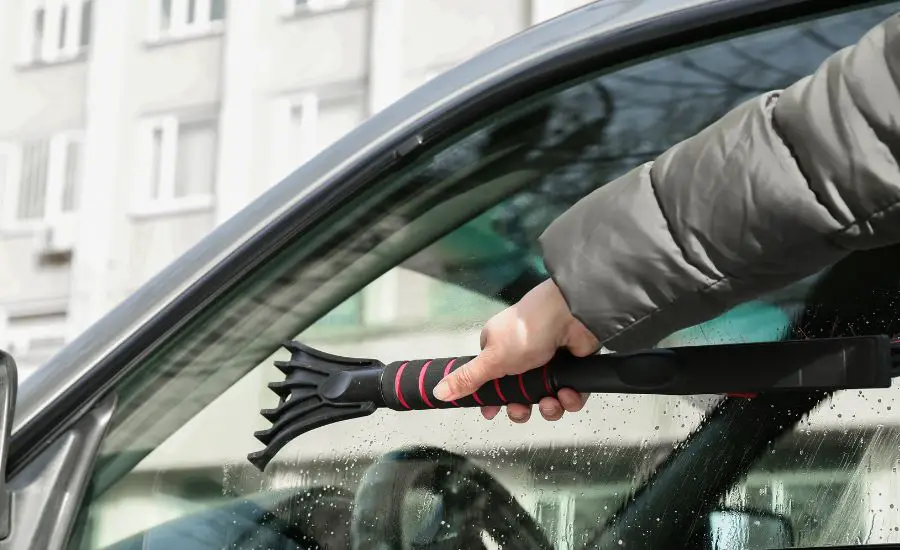
Safety first
It’s important to ensure all required safety gear is available before you start the spray paint removal process. Get Safety glasses to protect your eyes from splashes and debris, Use a protective mask, especially if you’re using chemical solutions, and ensure the protective mask is a high-quality one as some don’t work effectively enough.
Get high-quality rubber gloves to prevent skin contact with chemicals and sharp tools and wear long sleeve clothing to cover your arms and minimize skin exposure.
Make sure you’re working in a well-ventilated location if you’re working with chemical paint removers.
Paint removers may create dangerous fumes that, if inhaled for a lengthy period, could be harmful to your health.
To provide enough ventilation open all the windows in your garage or even consider moving the vehicle outside to maximize airflow.
Removing paint from car window
There are several approaches to removing spray paint or normal dried paint from car windows.
Prepare the surface
Choose a shady space to work on your car, cleaning spray paint can be more tiring in direct sunlight since cleaning agents can quickly evaporate, creating unwanted stains.
Check the window or car windshield for any loose contaminants, debris, or dirt before washing. If there are any larger particles, remove them using a plastic putty knife to avoid scratching the glass.
Start by rinsing the car window properly with clean water, and ensure that the glass is rinsed with enough water to completely free it from dirt that may hinder the removal process.
In your bucket, mix the detergent soap with warm water according to the manufacturer’s recommendations, make sure it’s not overly concentrated because too much soap can leave residues on the car windows.
After dipping your sponge or wash rag into the liquid detergent gently clean the glass with it, to evenly distribute the soapy mixture on the glass of the vehicle, move the rag across in a circular motion, making sure the spots where paint has been splattered are thoroughly coated.
You can use a plastic putty knife to remove stubborn pollutants like tree sap or road tar, apply the liquid detergent water mixture, then gently rub the plastic putty knife back and forth, this will remove embedded contaminants, rinse the area thoroughly after using the putty knife.
Rinse the soapy solution from the window with your hose or a bucket of fresh and warm water, make sure there are no soap traces left behind because they may hinder the removal of paint.
Use dry towels to completely dry the vehicle window after rinsing. This is particularly important to prevent the formation of water spots. Before beginning the paint removal process, be sure there are no lingering pollutants or residues.
Test any procedure or chemical on a small, unnoticeable region before applying it throughout the entire window.
This enables you to evaluate the interactions between the paint and your method of choice for removal, additionally, it might prevent unforeseen harm to the glass of your vehicle.
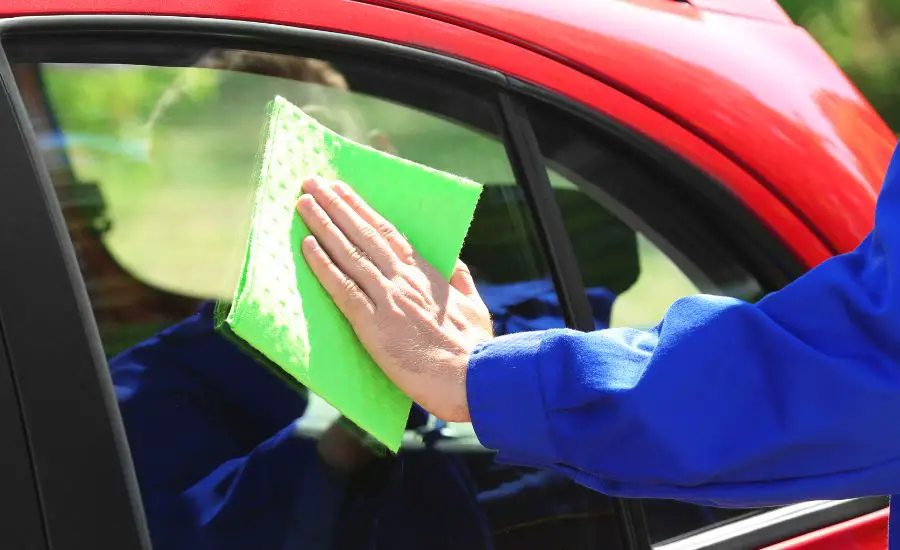
Cleaning oil-based paint
A very common and efficient way to remove oil-based paint is by using the nail polish remover acetone method, having paint on your mirror, window, or car windshield is likely due to a mark from a paint pen or paint overspray.
Test the acetone on a small, unnoticeable section of the window before applying it on the whole surface, this can help you guarantee that the acetone won’t harm the car window or other surrounding parts.
A clean, rag or cloth should be soaked in a small amount of acetone to remove lint, rub the oil-based paint splatters or oil-based paint stain gently in a circular motion with the damp rag and use moderate pressure. But avoid excessive scrubbing, as it could scratch the glass.
You might need to add more acetone and repeat it. Depending on the thickness and age of the oil-based paint, use a neat cloth to remove the loosening paint and extra acetone once the paint has softened and begun to come off.
When you have completely gotten rid of the oil-based paint, completely rinse the window with warm water in case acetone may still be present, and inspect the car window to ensure all traces of the oil-based paint are gone.
Cleaning water-based paint
Water-based paint is often simpler to remove from car windows than oil-based paint, water-based paint on your window can also be due to paint overspray.
You’ll need fresh and clean water, a water-based liquid detergent a soft sponge, and and a dry towel to remove spray paint or dried paint with this technique.
Mix warm water and the water-based liquid detergent with water and add the water-based liquid detergent. Make sure the water has completely dissolved the water-based liquid detergent, scrub the spray paint gently with a circular or back-and-forth motion, and rinse.
Dry the window completely with a towel that is clean and dry, and inspect the car windows to verify that all of the spray paint or water-based paint has been completely removed and that there are no traces of the water-based liquid detergent.
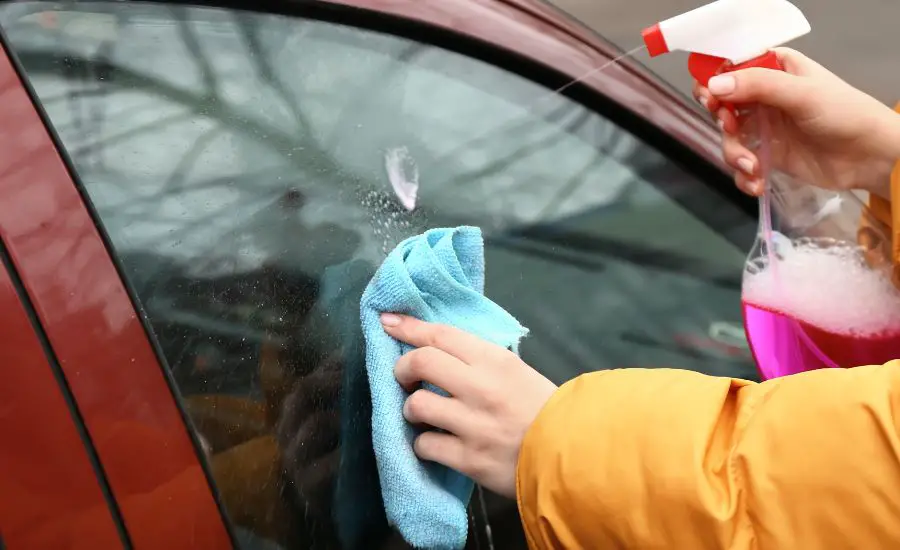
Using vinegar solution
Vinegar is another multipurpose cleaner that can assist in removing spray paint from car windows. Using vinegar to remove window paint from car windows is a simple process.
Begin by creating your vinegar solution by combining equal parts white vinegar and warm water in a spray bottle.
Spray the vinegar solution directly to the car window and allow the vinegar solution to sit on the paint splatters for a few minutes to soften the paint, once the paint has been removed.
Rinse the window with clean warm water to remove any remaining vinegar, and then use a clean cloth to remove the remaining paint and wipe the window clean.
Using a razor blade and lubrication
The razor blade procedure, commonly referred to as “razor blade scraping”, is a precise and amazing way to remove paint from car window. It’s suitable for water-based paint and effective for moderate paint splatters.
Spray the lubrication solution (warm soapy water or glass cleaner) to the paint splatters. This helps reduce friction on the surface and prevent scratching when you remove paint from car.
Hold the razor blade against the car window at a little angle(about 45 degrees), delicately use the razor blade on the glass, and remove as much paint as you can. Start at one edge and work your way across, keep the blade flat against the car window to effectively remove car window paint.
Reapply the lubrication solution as needed to help the blade glide smoothly and prevent scratching the window, Wipe the loosening paint and extra lubricant using a neat cloth, you can simply repeat the procedure if any paint is still on the war window.
Using toothpaste
Toothpaste is known for its mild abrasive features, making it a suitable choice for removing spray paint from the glass of vehicles.
Although handling toothpaste without hands is typically safe, you can consider wearing rubber gloves to avoid getting your hands dirty when removing paint with this paint removal technique.
Rub toothpaste on the car window paint gently using a soft cloth or towel in a circular motion while applying mild pressure, the toothpaste’s light abrasiveness should aid in removing the paint.
Rub continuously until you see the car window paint begin to come off. Be patient as this might not happen immediately, especially if it is a stubborn spray paint stain.
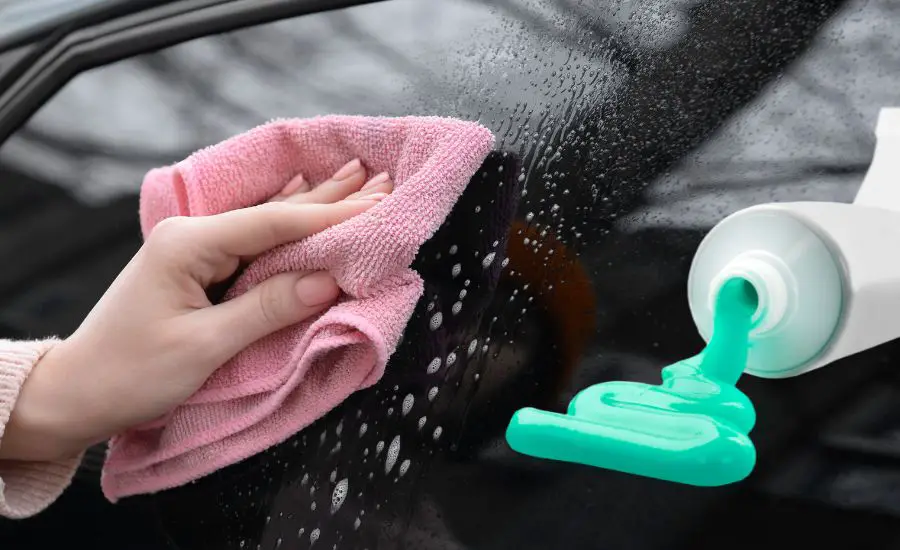
Using clay bar
This is another paint removal method that can also be used on glass surfaces to eliminate paint splatters.
This technique provides an additional layer of protection for your car glass and is appropriate for light paint splatters, spray the clay bar and the paint with the lubricant provided in the clay bar package.
Holding the clay bar flat against the car window, carefully brush the paint splatters with it and remove as much paint as you can.
Apply light to moderate pressure while keeping the surface lubricated, the paint impurities will be picked up by the clay bar.
Periodically knead and fold the clay bar to ensure that you’re not reintroducing paint particles to the car windows.
Wipe any lubrication remnant and remaining paint residue after using this paint removal technique.
Cleaning and finalizing
After successfully using any of the methods mentioned earlier, it’s essential to finalize and clean to ensure that the car windows are clear and ready for the road.
Once the paint has been completely removed, ensure you properly dispose of any waste, this includes the soiled paper towel, the used plastic putty knife, and chemical containers.
Regardless of the technique you employ to get the paint off, start by giving the car window a good, thorough rinse with warm water, this procedure ensures that any leftover paint remover residues are removed.
If you want to give your car window an extra shine, you can use a glass cleaner. Spray the glass cleaner on the window, and wipe it clean with a dry towel.
Use a polishing product to further improve the clarity and shine of your vehicle’s windows. Apply it to a clean cloth, and polish the glass. This procedure is especially useful if the window has minor blemishes or scratches.
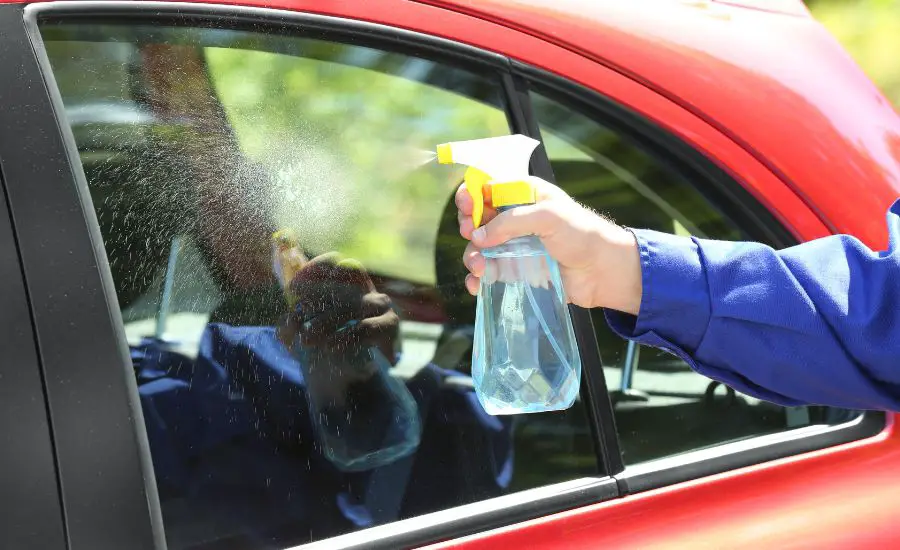
Choosing the right method
Consider the material of your car window. The majority of car windows are constructed using tempered glass, which is more scratch-resistant than ordinary glass.
Exercise caution. If your automobile has acrylic windows or if you’re unclear of the material because acrylic is more prone to scratching.
You should not undervalue your level of comfort or knowledge, it’s frequently safer to select a method that complements your abilities if you lack the appropriate gear or you lack experience with a certain removal technique.
Take into account the environment in which you plan to work. For instance, if you’re removing paint in an enclosed space, consider the ventilation and potential fume exposure when using chemical solvents.
If you’re working outdoors, wind and weather conditions can also impact your choice of method.
It’s advisable to run a test in a small, discrete area before deciding on a method for the entire window, this helps ensure that the technique you’ve chosen will work without risking destroying the glass.
Additional tips
- Patience. Painting glass can take a long time to remove, especially if the paint has been on the car windows for a long time, avoid rushing to prevent making mistakes.
- Monitor temperature. Avoid working on extremely hot or cold glass surfaces, as rapid temperature changes can cause stress cracks.
- Protecting surrounding areas. When using chemical removers, protect the surrounding areas of the car, including the paint, trim, and rubber seals, to prevent damage or discoloration.
- Check for tinted windows. Use chemical removers with caution if the car windows are tinted because this might change the color of the tint.
Mistakes to avoid when you remove paint
- Using abrasive materials. Using abrasive tools or cleaning pads to remove paint from the vehicle’s window is one of the most important mistakes to avoid, although abrasives like steel wool or abrasive scouring pads can appear to be useful for removing paint, they can seriously damage your car’s glass.
- Pressure. Applying too much pressure during the paint removal procedure is another frequent error. Abrasive scrubbing can have negative effects, including the potential for glass cracking. Although the glass in your car is made to be sturdy and resilient, it is not immune to damage.
- Rinsing. Properly rinsing the glass after removing paint is a critical step that should not be overlooked when you remove paint from a car, failing to rinse thoroughly can result in long-term damage to the glass, and residual chemicals from the paint removal process can adhere to the glass surface, potentially causing discoloration.
- Using excessive heat. Although it may be tempting to use heat to hasten the process when you remove paint from car, doing so can result in thermal stress and, in turn, cracks or damage to the glass, Excessive heat can cause the glass to rapidly expand and contract by creating an uneven temperature distribution over it.
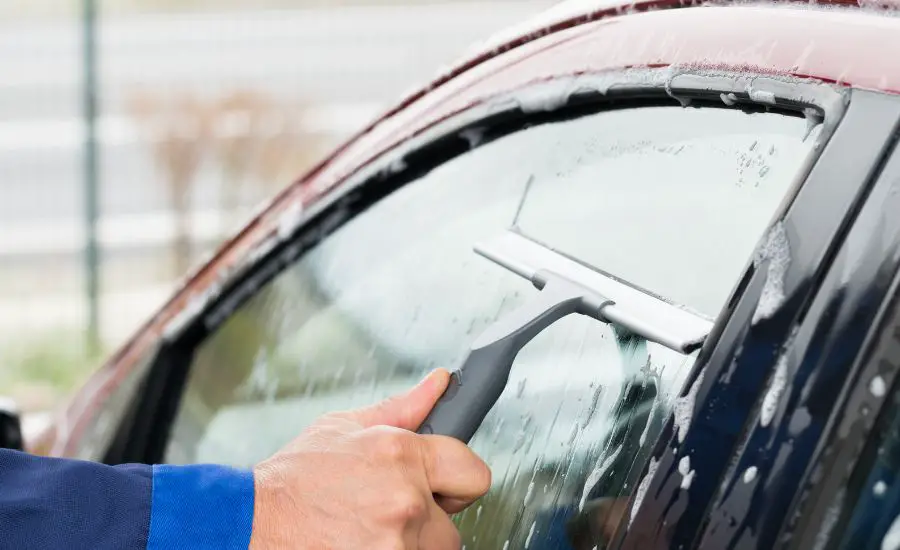
FAQ
How do you remove paint from car window glass?
A very effective cleaning method to remove paint from car is by applying acetone on the window surface with a rag or towel.
How do you get paint off of glass?
You can get rid of car window paint by using a clay bar, or toothpaste, or by applying acetone to the window of the vehicle.
What can I use to remove spray paint off my car window?
You can use a water-based liquid detergent to remove paint marks from the window of your vehicle.
Conclusion
There are several paint removal methods you can apply if you have paint marks on your vehicle window, by following safety precautions and using this article as a guide you can easily remove spray paint from car and maintain perfect car windows.
